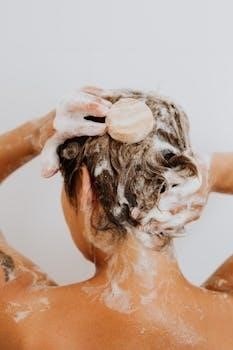
Checking the Care Label
Before cleaning your Jellycat, always check the sewn-in care label, typically located on the bottom․ This label provides specific instructions, indicating if the toy is machine washable, hand wash only, or surface wash only․
Location of the Care Label
The care label on your Jellycat is your primary guide for safe cleaning․ This crucial tag is usually sewn into the bottom of the toy․ It’s essential to locate this label before attempting any cleaning method․ The label contains symbols and text that specify the recommended cleaning approach; Always check the care label first, as different Jellycat designs have different cleaning requirements․ Ignoring this label could potentially damage your beloved plush toy․ This ensures the proper care, maintaining its soft and cuddly feel․ Always refer to the specific label on your Jellycat for the most accurate information․

Initial Cleaning Steps
Before any deep cleaning, start with surface washing․ This involves using a damp cloth and mild soap to gently clean the surface of your Jellycat, avoiding harsh chemicals․
Surface Washing Basics
For surface washing, gather a clean cloth, lukewarm water, and a mild, non-toxic soap․ Gently dampen the cloth with the soapy water, ensuring it’s not soaking wet․ Carefully dab the soiled areas of your Jellycat, avoiding rubbing harshly․ Once cleaned, use a separate cloth dampened with plain lukewarm water to rinse off any soap residue․ Allow the area to air dry completely․ This method is often recommended by Jellycat for general upkeep and spot cleaning, helping to maintain the plush’s integrity․
Machine Washing Jellycats
If the care label allows, machine washing is an option for more thorough cleaning․ Always prioritize checking the label first, as not all Jellycats are suitable for machine washing․
When Machine Washing is Allowed
Machine washing is permissible only if the care label explicitly states that your Jellycat toy is machine washable․ This is crucial because different designs may have varying care requirements․ If the label indicates machine washability, it’s essential to proceed with caution, ensuring that you follow the recommended cycle and temperature settings․ Some Jellycats are more delicate than others, and machine washing without checking can potentially damage the toy․ Always prioritize the care label’s guidance․
Using a Protective Bag
When machine washing a Jellycat, even if the care label allows it, using a protective bag is highly recommended․ A pillowcase or a mesh laundry bag can act as a barrier, minimizing friction and potential damage during the wash cycle․ This step helps to safeguard the toy’s delicate fur and features, preventing them from getting snagged or pulled․ The protective bag ensures a gentler wash, prolonging the life and maintaining the cuddliness of your Jellycat․ This extra precaution is especially beneficial for toys with delicate details․
Selecting the Correct Cycle and Temperature
If machine washing is permitted, select a gentle or delicate cycle on your washing machine․ This setting uses less agitation, reducing the risk of damage to your Jellycat․ Always use cold water when washing, as hot water can potentially harm the toy’s fabric and stuffing․ Avoid high-speed spin cycles, as these can be too harsh for plush toys․ A lower spin setting will help to protect your Jellycat․ Following these steps ensures a careful cleaning process, keeping your Jellycat soft, cuddly and in great shape after washing․

Hand Washing Jellycats
For Jellycats that require hand washing, use cool water and a mild detergent․ Gently wash the toy, avoiding harsh scrubbing․ Rinse thoroughly with cool water until all soap is removed․
Gentle Hand Washing Techniques
When hand washing your Jellycat, fill a clean sink or basin with cool or lukewarm water․ Add a small amount of mild, non-toxic detergent․ Submerge the Jellycat and gently massage the soapy water into its fur, paying attention to soiled areas․ Avoid harsh scrubbing or twisting․ Rinse thoroughly under cool, running water until all the soap is completely removed․ Gently squeeze out excess water, being careful not to wring the toy․ This gentle approach will help maintain its shape and softness․
Drying Your Jellycat
To maintain their soft and cuddly feel, avoid tumble drying․ Air drying is the preferred method for Jellycats․ Gently squeeze out excess water and reshape before drying․
Avoiding Tumble Dryers
It is crucial to avoid using tumble dryers for your Jellycat toys․ The high heat can damage the delicate fibers and cause matting or shrinking of the plush material․ This can lead to a change in texture and overall appearance of your beloved Jellycat․ Tumble drying can also cause deformation, making it lose its original shape․ Instead of tumble drying, opt for air drying to preserve its softness and shape․ Always follow the manufacturer’s recommendations to ensure your Jellycat stays in the best condition․
Air Drying Methods
Air drying is the gentlest method for drying your Jellycat․ After washing, gently squeeze out excess water․ Avoid wringing, which can damage the toy․ Reshape your Jellycat and lay it flat on a clean, dry towel or a drying rack․ Allow it to air dry completely in a well-ventilated area, away from direct sunlight or heat․ You can also hang it by a limb or the tag․ Ensure it’s fully dry before use to prevent mildew․ Periodically fluff the fur while drying to maintain its texture․
Specific Cleaning Methods
For heavily soiled Jellycats, a more thorough cleaning may be needed․ Submerge the toy in warm water with a tiny bit of gentle detergent․ Avoid harsh chemicals and excessive detergent․
Dealing with Heavy Soiling
When your Jellycat encounters significant soiling, such as oily stains or deeply embedded dirt, a more intensive cleaning approach is required․ Begin by submerging the plush toy in a basin or sink filled with warm water․ Add a very small amount of mild, non-toxic detergent to the water, ensuring not to use too much, as this can make rinsing difficult․ Gently agitate the water to distribute the soap and allow the toy to soak for a short period․ This will help loosen the grime and prepare it for a more thorough wash․ Remember to always check the care label before starting․
Daily Care and Maintenance
Regularly fluffing your Jellycat and gently reshaping its limbs will help maintain its form and charm․ A quick daily check can prevent matting and keep it looking its best․
Fluffing and Shaping
To keep your Jellycat looking its best, gentle daily maintenance is key․ Start by giving your Jellycat a good shake to wake it up․ Then, very gently pull the limbs and massage them to restore its pleasing shape․ Fluff the fur or hair as desired, using your fingers to separate any matted areas․ This simple routine will help maintain the toy’s original cuddly appearance․ Consistent attention to fluffing and shaping will ensure your Jellycat remains a cherished companion for years to come, keeping it soft and huggable․
Materials to Avoid
When cleaning your Jellycat, avoid harsh chemicals, bleach, and fabric softeners․ These can damage the toy’s delicate materials and affect its softness and color․ Use only mild detergents․
Harsh Chemicals and Bleach
It is crucial to understand that harsh chemicals and bleach are strictly prohibited when cleaning your Jellycat․ These substances can cause irreversible damage to the toy’s delicate fibers, potentially leading to discoloration, weakening of the material, and a change in its texture․ The use of such aggressive agents can also compromise the integrity of the stitching and overall construction of the Jellycat․ Furthermore, any residual chemicals can pose a potential health risk, particularly for young children․ Therefore, always opt for gentle and mild cleaning solutions to ensure the longevity and safety of your cherished plush friend․

FAQ Section
This section addresses common questions about washing Jellycat toys․ Find answers to queries about machine washing, drying, and general care to keep your plush friend clean and cuddly․
Common Washing Questions
Many owners wonder, “Can I put my Jellycat in the washing machine?” or “How do I deep clean a Jellycat?” Other frequent questions include, “Can Jellycats be tumble dried?” and “How to take care of Jellycat fur?”․ The answers to these questions vary depending on the specific care label instructions․ We’ll help you understand the best methods for maintaining the cleanliness and softness of your Jellycat, ensuring it stays a cherished companion for years to come, by addressing all the common washing concerns․

